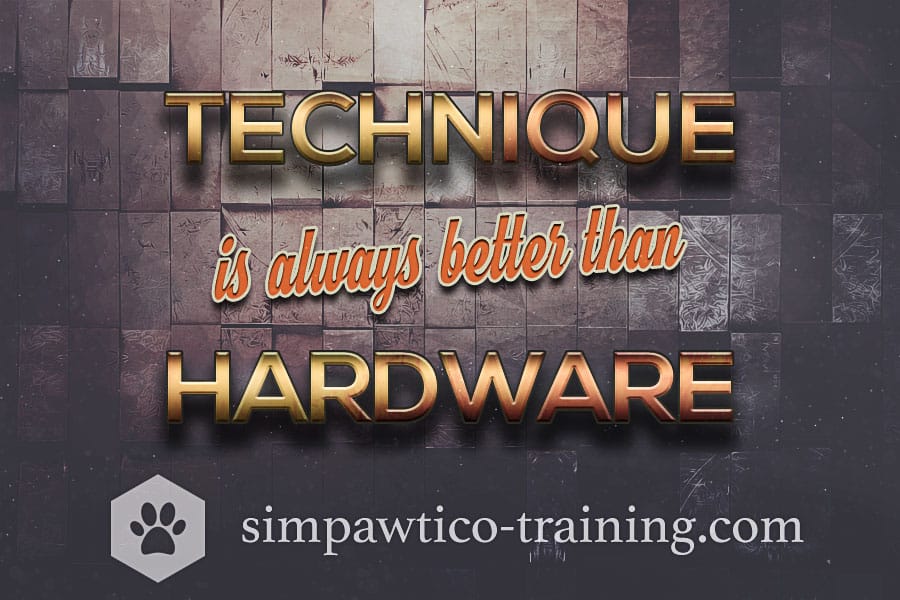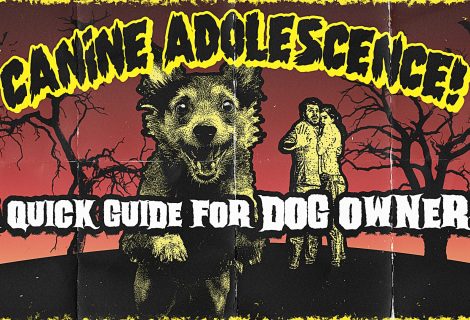Technique is Better Than Hardware
If you’ve spent any time around me, at my classes, or even just browsing my website, you’ve probably been exposed to one of my core beliefs: TECHNIQUE over HARDWARE.
AS SEEN ON T.V.
Many folks spend a lot of time and money hunting down bigger and better equipment to make their dogs behave. They saw a new harness in a magazine that works MIRACLES! Their friend told them about some contraption that straps to a dog, turning them into a whole new pooch! A vet tech sent them to the pet store to pick up the new leash/collar/strap/cord combo thingy that’ll do the trick! It speaks to our pervasive “As Seen On TV” culture that all of our problems can be solved if we spend money on the right things.
Unfortunately, we don’t want to hear that we must put work into something. We want to buy things that fix the problem for us. A special cleaner or detergent. A cool gadget. An app. Something immediate. Just take my damned money so I can finally live in peace! I’m sorry to have to tell you this: existing with another living thing is not covered in that pipe dream. It’s just like how all those things you wish you could change about your family or friends don’t magically get fixed when you buy something. Your dog isn’t furniture or a kitchen appliance. It has a brain, wants, needs, and feelings.
HARDWARE IS NOT INHERENTLY BAD
Don’t get me wrong: there is a time and a place for some pieces of hardware. As much as I hate them, there are even appropriate uses of prong collars. But these are all tools to help you fix a problem, not a cure unto itself. And really, that applies to any piece of hardware you get, be it a leash or even a harness. You’ve got to learn to do it without gadgets.
Once you have solid knowledge and technique under your belt, any of those pieces of hardware become way more effective. Wouldn’t you expect a mechanic to know how to use her tools? Wouldn’t you want your computer repairman to know how computers work? What makes you think you’re off the hook? Shouldn’t you learn about your dog first and then how to properly operate the tools next? And this is where I take issue—because I see well-meaning folks who love their dogs take bad info and compound it with hardware that they don’t know how to use properly.
The training collar, the shock collar’s remote, the no-pull harness, the retractable leash…even ridiculous things like cans of pennies and spray bottles (complete rubbish, both of them) won’t get you where you want without knowing how to do it right. And as often as I harp on prong collars, my greatest gripe is that in the years I’ve been training, I’ve seen one used and fit correctly on a dog exactly one time, out of all the hundreds of times I’ve seen a dog with one. Even that tool would be more effective and humane if owners were better educated.
Here’s another way to look at it: you could have the greatest, most high-performance car in the world, but if you’re a crappy driver, you might as well drive a Pinto.
A FALSE SENSE OF SECURITY
The problem with most of these objects is that you probably will get some improvement. Initially, you’ll see just enough of what you want so that you’ll a) keep trying and b) convince yourself it’s more effective than it really is. It’s like a slot machine, and we keep pulling the lever. It’ll be just enough to hook you, and you’ll use that special collar or harness forever. Please understand, friends, that these things rarely (if ever) really fix your problem. It will just cover it up well enough for you to get by.
LEARN HOW TO DO IT FIRST BEFORE RELYING ON GEAR
When I work with an unruly or aggressive dog, I try to do as much as possible without the hardware. I apply technique and knowledge to come at it, not objects. And I start establishing organic lines of communication with the dog.
And I want the same for you! Your trainer’s job is to teach YOU the techniques, the timing, the motions, and the master keys like a ballet teacher or martial arts sensei. It’s a matter of the interactions between you and your dog, not a factor of objects or things. Spending your money on appliances and gadgets, hoping they will magically transform your dog into a good one, is ignorant and lazy. I’m sorry…you know I can’t candy-coat.
No matter what, learn some technique. Find a trainer who uses positive reinforcement, understands how dogs learn, and utilizes sound mechanics of effective techniques. Find one who can coach and encourage YOU on that technique. Then, if you REALLY need that special harness or that prong collar, you can then learn how to use it right. You’ll be able to accomplish ten times what you’d expected and a hundred times more than what you got before! Otherwise, you’re that schmuck in the race car grinding gears in the drive-thru. Don’t be that guy! We can do better!








Hi Ian,
My wife and I have been watching your YouTube videos and find it very informative. We like your approach.
We have a 3+ month old golden retriever boy. We have been training him since the day we got him. We want a solid foundation both for him as a puppy and for us as pet parents so we 3 can have a good life. All the trainers we have come across in Charlotte, NC-suggested by our vet and breeder seem to use e-collars in their trainings. These trainers come highly recommended. We are not sure if e-collar is needed for a puppy or even if its humane. We have found polarizing opinions about e-collar making it really hard for us decide. It would be of great help if you can shed some light on e-collar, its usage, if it will cause any psycological or physical harm and if we should avoid all the trainers/trainings that use them.